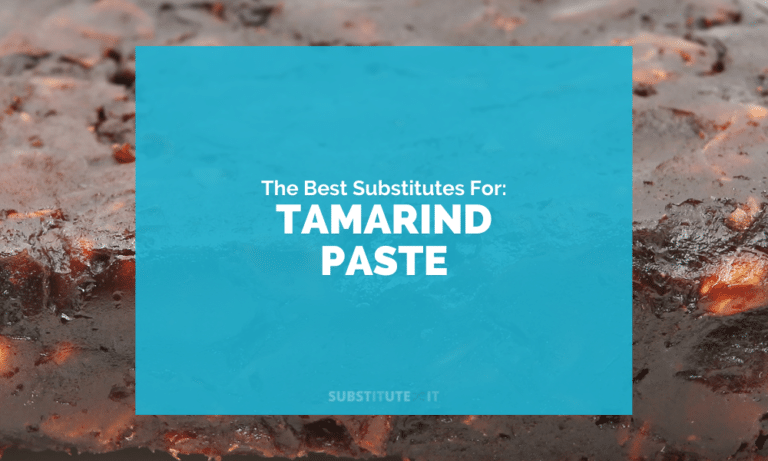As a popular ingredient in many Indian and Asian dishes, tamarind paste is made from the sticky tamarind fruit.
Though at first glance, tamarind seems like a rare ingredient to have in your everyday local supermarket, it is fairly easy to hunt down in the western world. However, it can be quite costly.
So, what can you use instead of tamarind paste the next time you want to taste the eastern world?
Our 4 Substitutes for Tamarind Paste
Tamarind paste is the perfect mix of sweet and sour with explicit citrus undertones. It is like a full sauce in itself and is packed full of flavours.
Here are our top 4 substitutes you can use instead of tamarind paste:
1) Pomegranate Molasses
When pomegranate juice is cooked down, it is reduced to a thick, darkly coloured syrup. Though it is not thick enough to be used as a paste.
If a recipe specifically uses tamarind paste for its thick consistency, then you will need to use corn starch or flour to make the pomegranate molasses fit the needs of the recipe. In most cases, slightly runnier molasses will still work fine – especially in marinades and curries.
Just like regular molasses, it has a heavy tartness but is balanced out by the natural sweetness of the pomegranate flavouring.
Still, you should only use half as much pomegranate molasses compared to tamarind paste so that its tart sweetness doesn’t overwhelm your dish.
Make Your Own
Pomegranate molasses is easy enough to make at home so long as you have a few hours to spare so that you can make sure the pomegranate juice doesn’t burn while reducing.
If you want a quick fix solution, buy some molasses, and mix in some pomegranate juice. It will not be anywhere near the right consistency but will hit all the essential flavours of tamarind paste.

2) Worcestershire Sauce
As far as flavour goes, Worcestershire sauce is the closest you can get to tamarind paste while still on a budget.
By itself, Worcestershire sauce will not resemble tamarind paste. It will be far too mild of a flavour despite having a balanced sweet and sour profile.
To make Worcestershire sauce taste exactly like tamarind, all you need to do is combine Worcestershire sauce, water, lemon juice (or vinegar), brown sugar and a little bit of tomato paste.
These are all easily accessible ingredients and will create a flavour almost indistinguishable from tamarind paste.
It will be acidic, sweet, sour, and tart. Perfect!
Budget Worcestershire Sauce
If you do not have Worcestershire sauce to hand and do not have the listed ingredients to make your own, you can make a very basic version using lemon juice, ample tomato paste and water.
You will get sourness from the lemon and sweetness from the tomato paste. It may not create a complex dish, but you will hit the important flavours of tamarind paste.
3) Lime Juice and Brown Sugar
Perhaps the easiest and most obtainable substitute for tamarind paste available, lime juice and brown sugar can be combined to create an effective sweet and sour taste.
Lime juice is naturally tart and bitter, but by adding brown sugar to the mix, you will be able to balance out its sweetness. Lime also has a clear citrus flavour that is also evident in tamarind paste.
Brown sugar itself creates a significantly richer, more developed dish than white sugar does due to being made from sugar and molasses.
Can You Use Bottle Juice?
The fresh lime juice will always be the better ingredient when it comes to savoury foods. However, in this case, bottled lime juice will work fine. You should reduce the amount of brown sugar you add to the juice though as bottled lime juice does tend to be sweet already.

4) Rice Vinegar and Brown Sugar
Working similarly to lime juice and brown sugar, mixing rice vinegar and brown sugar will produce a combination of sweet and sour.
Rice vinegar is made from fermented rice so will be sweeter than most other substitutes. However, this will even out spicy dishes.
Still, you will need the added brown sugar to make the rice vinegar sweet enough to match the flavours of tamarind paste and to counteract the vinegar’s natural sourness.
The combination will not create a thick paste, nor will it hit all the right flavours of tamarind paste perfectly. But when used in a marinade, rice vinegar and brown sugar will work fine together.
Stick to Rice Vinegar
If you do not have rice vinegar to hand then use a different substitute instead of swapping the vinegar out with another variety.
Rice vinegar is completely different to other kinds of vinegar which have harsh, overly sour flavours that even extra brown sugar won’t be able to balance out.
Other Substitutes for Tamarind Paste
The above substitutes will create strong sweet and sour combinations which is why they are the preferred substitute choices. But here are some other, simple ingredients that will require less work from you:
- Marmalade – Made using whole citrus fruits and sugar, marmalade will have a mild sweet and sour combination. Though you should be wary of any whole seeds or peels.
- Mango Chutney – Already a key Indian and Middle Eastern staple, mango chutney will be more bitter than sour but has enough sweetness and citrus notes to make it worth a try.
Summary
To conclude, tamarind paste is bursting full of flavour. Its sweet and sour notes are hard to replicate as it is so unique.
But there are a few ingredient combinations and single ingredients that strike a similar balance to tamarind paste. The most successful is pomegranate molasses.
